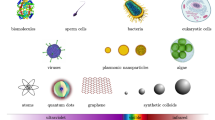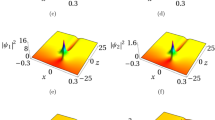Summary
The quantum mechanical theory of rotary dispersion leads to the rule that the sum of the rotational strengths Σa r of the various terms in a dispersion formula of the Drude type expressed in terms of the characteristic frequencies should be zero. It is shown in this paper that the rotary dispersion formulæ for quartz which had been proposed earlier do not satisfy this summation rule. On the other hand, the single-term formula of the formρ=Kλ2/(λ2−λ0 2)2 suggested by the present author which fits the data along the optic axis accurately from the visible to the ultra-violet region of the spectrum, fulfils the summation condition. It is also shown that the data of Bruhat and Grivet for the rotary dispersion of quartz normal to the optic axis is fitted well by a formula of the same form as that given above if we put K=−3·56 and λ0=0·111355µ.
Similar content being viewed by others
References
Bruhat, G. and Grivet, P...J. de Phy., 1935 (7),6, 12.
Chandrasekhar..Proc. Ind. Acad. Sci., 1952,35 A, 103.
Condon, E. U...Rev. Mod. Phys., 1937,9, 432.
Kuhn, W...Z. f. Physik. Chemie, 1929,4 B, 14.
Rosenfeld, L...Z. f. Phys., 1928,52, 161.
Author information
Authors and Affiliations
Additional information
Communicated by Sir C. V. Raman,f.r.s., n.l.
Rights and permissions
About this article
Cite this article
Chandrasekhar, S. Some remarks on the optical rotary dispersion of quartz. Proc. Indian Acad. Sci. (Math. Sci.) 36, 118 (1952). https://doi.org/10.1007/BF03172308
Received:
DOI: https://doi.org/10.1007/BF03172308




